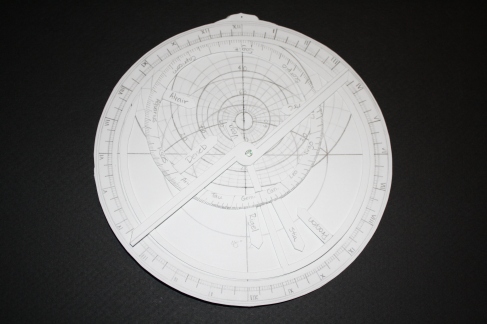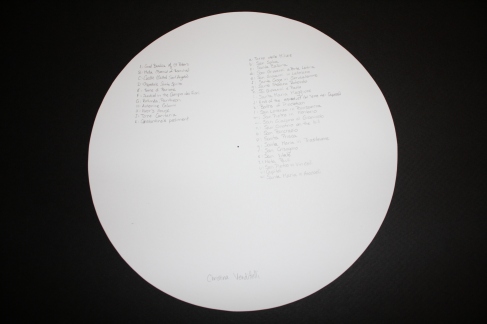«La théorie d’Alberti est presque entièrement basée sur le système de notation entre le design et le bâtiment, impliquant que les dessins peuvent et doivent, être identiquement transmis à l’objet tridimensionnel. Dans sa théorie, le design du bâtiment est l’original, et le bâtiment lui-même est une copie.» Alberti était véritablement obsédé par la division entre le travail de l’auteur et la reproduction. Il a inventé plusieurs dispositifs pour faciliter la connexion entre le projet et le bâtiment construit. En fait, les copistes faisaient souvent des erreurs, parfois ils inventaient, interprétaient ou interpolaient ce qu’ils avaient à copier. Alberti pensait que des mots et des chiffres pouvaient voyager mieux dans le temps et dans l’espace, plus rapidement et avec moins de risques. La fidélité d’une copie à la main était inversement proportionnelle à la complexité du dessin, et de sa ressemblance à un archétype (comme une forme géométrique).
Alberti utilisait rarement des illustrations complexes dans ses livres, choisissant simplement de ne pas montrer ce qui était difficilement reproductible. Il les remplaçait par des descriptions, avec parfois des systèmes composés de lettres et de chiffres. On pourrait affirmer que déjà, entre 1430 et 1440, dans sa Descriptio urbis Romae, Alberti a créé la toute première image digitalisée, dans un système de coordonnées polaires. Le lecteur est amené à dessiner lui-même sa carte de Rome, tel un traceur ou une imprimante. Alberti a utilisé cette idée pour annoter plusieurs bâtiments, objets, peintures, et même des sculptures. Il a d’ailleurs suggéré l’idée que si des parties d’une sculpture sont produites dans tes ateliers différents, ces parties pourraient s’emboîter parfaitement, comme dans un système préindustriel Tayloriste. Bien entendu, les inventions d’Alberti ne sont pas parfaites, dû notamment à la technologie elle-même, l’erreur humaine étant toujours possible.
Selon Mario Carpo, dans notre culture Occidentale moderne nous assistons à l’inversion du paradigme Albertien. L’ère digitale a fortement déterminé les bases et les standards en architecture. Il est maintenant possible de reproduire des copies parfaitement identiques, mécaniquement, et cela a un impact sur notre environnement construit. Cela affecte indéniablement notre culture visuelle et nos fonctions et valeurs de signes.
Source : The Alphabet and the Algorithm, Mario Carpo
La carte réalisée fait un diamètre de 400 mm et a été entièrement dessinée à la main à la plume fontaine et au crayon à la mine sur du carton. La règle est en bois (tilleul).
–
«Alberti’s entire architectural theory is predicated on the notational sameness between design and building, implying that drawings can, and must, be identically translated into three-dimensional objects. In Alberti’s theory, the design of a building is the original, and the building is a copy.» He was obsessed by the division between the work of the author and the reproduction. Alberti made a lot of inventions to facilitate the translation between the project to the constructed building. In fact, the copyists often make mistakes, sometimes they can invent, interpretate or interpolate what they have to copy. Alberti thought that texts and numbers could better travel in time and space, faster and more safely than images. The fidelity of a handmade copy drawing was an inverse proportion to the complexity of the drawing, and of its distance from the archetype (like simple geometries).
Alberti rarely used complex illustrations in his books, he simply chose to not show what is hardly reproductible. He replaced them by descriptions, with numerical or letter-based strategies. We could say that even around 1430-1440, In the Descriptio urbis Romae, Alberti has created the first digitalised image using a system of polar coordinates. Then, the reader is involved in a DIY process, where he is the «plotter» of the image. Alberti used the same idea to notate buildings, objects, paintings and sculptures, he even suggested that the parts could be produced in different workshops and they would fit perfectly, like in a pre-industrial, taylorist system. Of course, that system is not perfect because of the technology itself, in those inventions the human mistake is still possible in the process.
According to Mario Carpo, in our modern Western culture, we assist at the reversal of the Albertian Paradigm. The digital time have determined a lot of the basics and the standards in architecture. It can produce exactly repeatable, mechanical imprints and it has an impact on our visual envrionnement. It indeniably affects our visual culture, our functions and values of signs.
Source : The Alphabet and the Algorithm, Mario Carpo
The map realized is all drawn by hand with fountain pen and pencil on thick paper, the map has a diameter of 400 mm. The rule is in wood.
Émélie DT





































